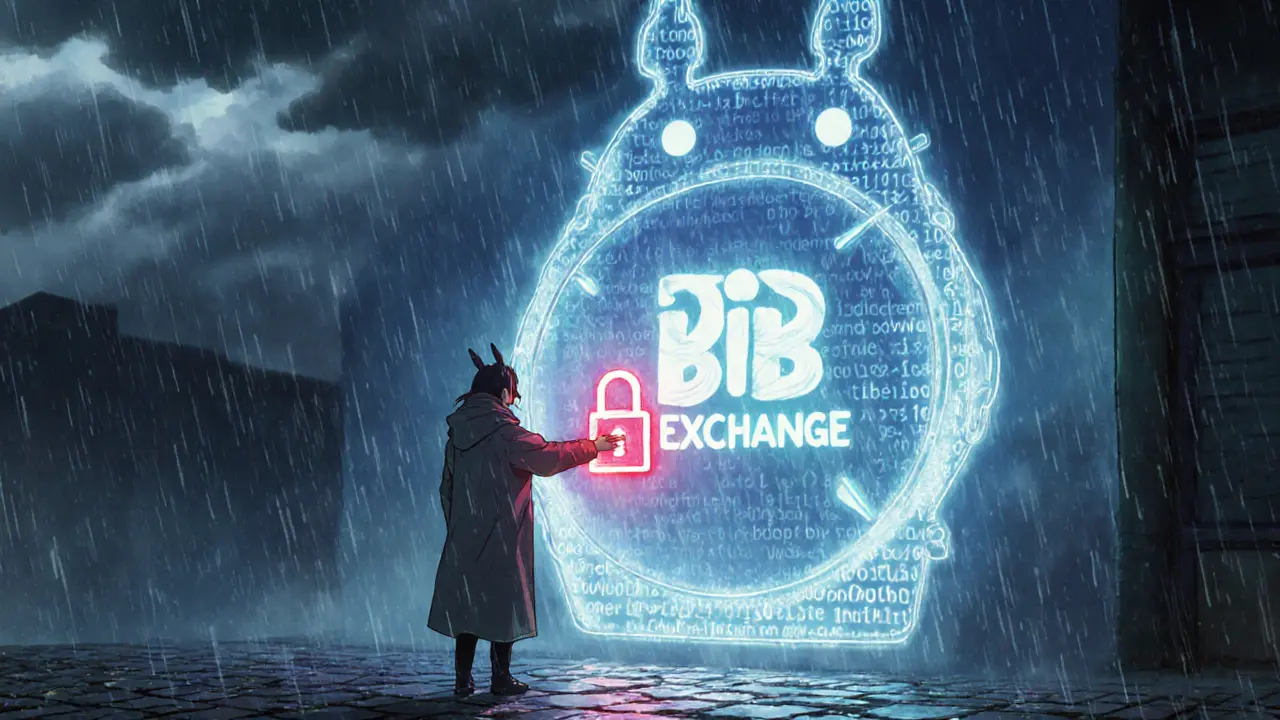6
BIB Exchange Review: Is This Crypto Platform Safe or a Scam?

BIB Exchange Risk Assessment Tool
Evaluate BIB Exchange Risks
Answer the following questions to assess the potential risks of using BIB Exchange.
Risk Assessment Result
If you're searching for a reliable BIB Exchange review, you’ve come to the right place. Below we break down what the platform claims, how it actually works, and why regulators are waving red flags. By the end you’ll know whether BIB Exchange belongs in your crypto toolkit or on a watch‑list.
TL;DR
- BIB Exchange markets itself as a Binance Smart Chain‑based CEX with over 2million users.
- Offers spot, futures, options, NFT minting and a suite of high‑yield earning products (up to 40%APY).
- Regulators in Washington State have issued a fraud alert, citing withdrawal problems and possible advanced‑fee scams.
- Security claims (multi‑layer wallets, DDoS protection) clash with real‑world user reports of locked funds.
- Compared with Coinbase, Binance and Kraken, BIB lacks verifiable licensing, insurance funds and third‑party audits, making it a high‑risk choice.
Platform Overview
When you first land on BIB Exchange is a centralized cryptocurrency trading platform built on Binance Smart Chain technology, the branding feels glossy: a sleek homepage, a promise of “global” reach, and a user count in the millions. The site (bibvip.com) positions itself as a one‑stop shop for trading, staking, NFT minting, and a menu of “wealth‑building” products. Its native utility token, $BIB serves as the medium for transaction fees, reward distribution and platform governance. While the tech stack claims to leverage the speed and low fees of Binance Smart Chain provides a high‑throughput blockchain environment for fast swaps and token issuance, the real question is whether the operational layer lives up to those promises.
Features & Technical Specs
On paper, BIB Exchange offers the typical toolbox of a modern crypto exchange: spot trading for major coins, futures contracts, options, a coin‑swap engine and a staking portal. The platform also touts an NFT marketplace where users can mint assets using QR‑code technology - a novelty meant to simplify on‑chain minting for mobile users. Security‑savvy language populates the site, citing “over 30 protection mechanisms” such as multi‑layer wallet segregation, DDoS mitigation, traffic cleaning and automatic risk management. Yet each of these claims is presented without third‑party audit reports or certifiable certifications, leaving a gap between marketing hype and verifiable safety.
Earning Products & Returns
Where BIB Exchange truly differentiates itself is in the suite of high‑yield products. The “Periodic Wealth Management” plan advertises a 7.0%APY in USDT, while a “Fund Investment” option boasts a staggering 40%APY, also in USDT. Other offerings include “Easy Earn” (1.47%APY in BTC), “$BIB Pledge” (2.6%APY in BIB) and a “Wealth Box” that promises passive income via algorithmic strategies. These numbers dwarf typical staking yields on reputable platforms and immediately raise a red flag for regulators, who often view such promises as bait for advanced‑fee fraud.

Regulatory Status & Fraud Warning
According to its own documentation, BIB Exchange claims to operate under a U.S. Money Services Business (MSB) License - specifically License Number 31000219137978 is presented as proof of compliance. However, an MSB registration with FinCEN does not equate to a full securities licence nor does it guarantee consumer protection. The crucial piece of the puzzle comes from the Washington State Department of Financial Institutions (DFI) the agency issued an official consumer alert stating that BIB‑related domains may have engaged in fraud. The alert labels the activity as “Advanced Fee Fraud” and “Asset Recovery Scam,” citing investor complaints where withdrawals were repeatedly denied.
User Experience & Withdrawal Issues
First‑hand accounts from the DFI complaints describe a pattern: users deposit crypto or fiat, see promised earnings appear on the dashboard, but when they try to cash out the platform either blocks the request or delays it indefinitely. One documented case involved an investor who attempted multiple withdrawal requests over several weeks, only to receive automated “processing” messages while the funds remained locked. These experiences directly contradict BIB’s advertised “flexible and secure” withdrawal policy and are typical of platforms that operate on a Ponzi‑style cash‑flow model.
How BIB Stacks Up Against Established Exchanges
| Feature | BIB Exchange | Coinbase | Binance | Kraken |
|---|---|---|---|---|
| Regulatory Licensing | MSB claim, no major exchange licence | USA & EU banking licences, SEC‑registered | Malta & Singapore licences, global compliance | US & EU licences, FCA‑registered |
| Insurance Fund for Users | None disclosed | US$250M insurance pool | SAFU fund (≈$1B) | Insurance for hot wallet assets |
| Audit Transparency | No public third‑party audits | Annual SOC 2, independent audits | Regular security audits, bug bounty | Annual audit reports, code reviews |
| High‑Yield Products | Up to 40%APY (USDT) | Staking 5‑7%APY, no guaranteed returns | Earn products 4‑12%APY | Staking & liquidity mining 3‑10%APY |
| Withdrawal Reliability | Frequent delays, reported blocks | Instant to US bank, predictable | Typically within minutes, occasional queues | Usually < 24h, transparent process |
The table makes it clear that BIB Exchange lags behind in every core trust metric. While the high‑yield products look tempting, they come with a price tag of regulatory risk and operational opacity.
Verdict & Recommendations
In the current regulatory climate of 2025, a crypto exchange needs verifiable licences, insurance coverage, and regular security audits to earn user confidence. BIB Exchange falls short on all those fronts and has an active fraud warning from a U.S. state regulator. The platform’s marketing emphasizes returns that dwarf market averages, a classic hallmark of scams that rely on new deposits to pay out promised earnings.
For anyone serious about crypto trading or passive income, stick with exchanges that are listed on reputable tracking sites (CoinMarketCap, CoinGecko), have clear jurisdictional oversight, and provide transparent fee structures. If you still want to explore BIB Exchange, limit exposure to an amount you can afford to lose, and always verify withdrawal capabilities with a small test deposit first.
Frequently Asked Questions
Is BIB Exchange legally registered?
BIB Exchange claims a U.S. Money Services Business (MSB) licence, but it lacks a full securities or exchange licence from major regulators. The MSB registration alone does not guarantee consumer protection.
Can I safely withdraw my funds from BIB?
User reports and the Washington State DFI alert indicate repeated withdrawal blocks. Until the platform demonstrates reliable payouts, withdrawals remain high risk.
What are the main differences between BIB Exchange and Binance?
Binance operates under multiple global licences, maintains a large insurance fund (SAFU), and publishes regular security audits. BIB Exchange offers higher APY products but lacks verifiable licences, insurance, and audit transparency.
Should I trust the high‑APY offers on BIB?
Historically, guaranteed returns above 20%APY on crypto platforms have been linked to Ponzi‑type schemes. Treat such offers with extreme caution and never invest more than you can lose.
How can I verify if a crypto exchange is legitimate?
Check for official licences on regulator websites, look for third‑party security audits, confirm the presence of an insurance fund, and review user experiences on independent forums. Listings on CoinMarketCap or CoinGecko add an extra layer of credibility.











Amie Wilensky
November 6, 2024 AT 11:33Contemplating the allure of sky‑high APY, one cannot help but ask: is the promise of 40% a mere mirage, or a beacon of financial evolution?; the answer, perhaps, lies not in the numbers themselves, but in the invisible scaffolding of regulatory oversight; a structure, fragile as glass, that shatters under the weight of unverified licences; and yet, the market, ever‑hungry, devours such symbols of wealth, heedless of the hidden fissures; thus, the BIB Exchange stands as a paradox-glimmering yet precarious; its advertised multi‑layer wallets, touted as fortresses, remain untested in the public arena; without third‑party audits, trust becomes an abstract construct; the Washington State alert, a stark reminder, punctuates this narrative; in the end, the philosophical dilemma persists: do we chase returns, or pursue security?; the prudent path, arguably, embraces both, but rarely in equal measure.
MD Razu
November 13, 2024 AT 10:13When evaluating BIB Exchange, one must first dissect the veneer of technological bravado that it projects; the platform’s claim of Binance Smart Chain integration is, on its face, a compelling narrative that promises speed and low fees, yet the substance behind that promise warrants rigorous scrutiny; the absence of verifiable regulatory licensing, despite the superficial MSB registration, raises immediate concerns about jurisdictional compliance and consumer protection; users are enticed by staggering APY figures that eclipse market norms, a classic hallmark of schemes that rely on influxes of fresh capital to sustain promised payouts; withdrawal reports from numerous complainants illustrate a pattern of delayed or outright blocked transactions, suggesting a liquidity mismatch or intentional obstruction; the Washington State Department of Financial Institutions’ fraud alert serves as an authoritative red flag, corroborated by a constellation of victim testimonies across forums; moreover, the platform’s security posture, while adorned with buzzwords such as “multi‑layer wallet segregation” and “DDoS mitigation,” remains unsubstantiated in the absence of third‑party audit documentation; in the broader ecosystem, established exchanges like Coinbase, Binance, and Kraken maintain transparent licensing, insurance funds, and regular audit cycles, establishing a stark contrast; investors seeking genuine exposure should prioritize these proven custodial safeguards over speculative yield promises; the risk–reward calculus tilts heavily toward risk given the confluence of regulatory opacity, withdrawal instability, and implausibly high returns; prudence dictates that any capital allocated to BIB Exchange be limited to an amount one can comfortably forfeit; even then, a prudent strategy would involve a preliminary test deposit, monitoring the exit process before committing larger sums; the underlying lesson resonates across the crypto sphere: extraordinary returns demand extraordinary due diligence; without concrete evidence of financial robustness, the platform’s allure is eclipsed by its potential for loss; consequently, the rational investor should either avoid BIB Exchange altogether or approach it with the utmost caution and limited exposure.
Charles Banks Jr.
November 20, 2024 AT 08:53Oh, sure, because crypto platforms with glossy marketing always deliver on those “up to 40% APY” promises-just like a unicorn on a diet of rainbows. Nothing says “trustworthy” like a website that screams security while ghosting withdrawals.
Ben Dwyer
November 27, 2024 AT 07:33It's understandable to feel uneasy after reading about those withdrawal complaints. If you decide to test the waters, start with a small amount and keep a close eye on the process. That way you protect yourself while still exploring what the platform offers.
Lindsay Miller
December 4, 2024 AT 06:13The situation with BIB Exchange can be confusing, especially when the promises seem too good to be true. It helps to compare it with well‑known exchanges that have clear licensing and insurance. By doing that, you can see where the gaps are and make a safer choice.
Katrinka Scribner
December 11, 2024 AT 04:53Wowww sooo many promises!!! 😱💸 But like, did anyone actually get their money back? 🤔 I saw some folks say “it’s a scam” lol 😂 but also some happy ppl w/ 💰. Honestly, I’m not sure – maybe try a teeny bit and see? 😅
VICKIE MALBRUE
December 18, 2024 AT 03:33Stay hopeful and keep learning.
Waynne Kilian
December 25, 2024 AT 02:13i think its importent to check the regualtory status of any platform before investin. many of the high apy offers are just bait for scammy opertaions. compare with known exchanges like binance or coinbase for safety.
Naomi Snelling
January 1, 2025 AT 00:53They’re probably using BIB to funnel money into a hidden agenda.
Michael Wilkinson
January 7, 2025 AT 23:33Enough of the sugar‑coated hype. The facts are clear: licensing is dubious, withdrawals are blocked, and the APY is astronomically unrealistic. Anyone still considering it is ignoring red flags.
Billy Krzemien
January 14, 2025 AT 22:13The prudent approach is to verify the exchange’s licensing on official regulator websites, confirm the presence of an insurance fund, and look for publicly available security audit reports. These steps provide objective criteria beyond marketing claims.
april harper
January 21, 2025 AT 20:53In the theater of crypto promises, BIB Exchange plays the role of the dazzling illusionist, offering glittering returns while the curtains conceal the mechanisms. One must watch the stage carefully.
Clint Barnett
January 28, 2025 AT 19:33Imagine a kaleidoscope of glittering promises, each hue representing a different high‑yield product that BIB Exchange flaunts with reckless abandon; the platform’s narrative is painted in bold strokes of “up to 40% APY,” yet the underlying canvas is riddled with gaps where regulation and transparency should reside. When you peel back the layers, you encounter a mosaic of user testimonies-some claiming modest gains, others recounting locked funds and endless support tickets. The juxtaposition of a sleek UI against the stark reality of withdrawal delays reads like a cautionary tale for the unwary. Moreover, the absence of third‑party audits is akin to an artist refusing to let critics examine their work, leaving observers to speculate about hidden flaws. Regulatory red flags, such as the Washington State fraud alert, add a somber undertone to this otherwise vibrant display. In the end, the prudent investor must decide whether to admire the artwork from afar or step onto the stage, risking a tumble into obscurity.
Jacob Anderson
February 4, 2025 AT 18:13Sure, because history has shown us that every platform promising double‑digit yields without oversight ends up being a shining example of financial integrity.
Kate Nicholls
February 11, 2025 AT 16:53BIB Exchange certainly offers enticing features, yet the lack of verifiable licensing and the reported withdrawal issues cannot be overlooked. A careful risk assessment suggests limiting exposure until clearer compliance evidence emerges.
Carl Robertson
February 18, 2025 AT 15:33The drama surrounding BIB Exchange reads like a bad sitcom; the plot twists are all about blocked withdrawals and lofty APY fantasies, while the supporting cast of regulators delivers the inevitable climax-exposure of the scam.
Rajini N
February 25, 2025 AT 14:13For anyone evaluating BIB, start by checking the FinCEN MSB registration number on the official database, then look for any SEC or state securities filings. Next, search for third‑party security audit reports-if none are found, treat the platform with skepticism. Finally, test the withdrawal process with a minimal amount to confirm that funds can move out as advertised.
Sidharth Praveen
March 4, 2025 AT 12:53Even in a landscape dotted with risky projects, there’s always room for diligent research to uncover safer opportunities; keep an eye on the fundamentals and you’ll navigate wisely.
Sophie Sturdevant
March 11, 2025 AT 11:33The platform’s tokenomics are riddled with hyper‑inflationary supply mechanisms, opaque fee structures, and yield farming incentives that lack verifiable liquidity pools, making it a high‑risk, low‑return proposition for any serious portfolio.
Nathan Blades
March 18, 2025 AT 10:13When the crypto market roars with promises of astronomical returns, the wise trader listens to the quiet voice of due diligence; by dissecting licensing, audit transparency, and withdrawal reliability, you transform uncertainty into strategic advantage.
Somesh Nikam
March 25, 2025 AT 08:53Hey there! 🌟 Remember, a solid crypto strategy starts with verification-check licenses, audit reports, and test withdrawals. Stay safe and keep learning! 👍
Jan B.
April 1, 2025 AT 07:33Check licenses verify audits limit exposure.